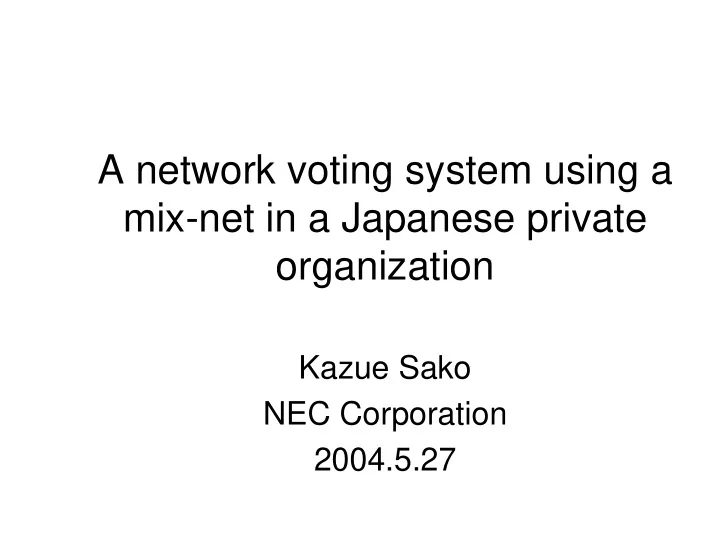

A network voting system using a mix-net in a Japanese private organization Kazue Sako NEC Corporation 2004.5.27
Background: Electronic Voting in Japan • Law established in 2001, effective 2002 – voting at polling place – for local government election only – no network between polling place and tallying center – absentees ballot are still paper-based, all write-ins • Held in nine local elections – Objections raised in two elections • Unable to vote over an hour for machine problems Mismatch in # of voters and # of votes by 6. • 2582 blank votes in a 49 votes difference race (60,000votes)
Overview of our work • Aim: a voting system for private organization – That votes are cast over network – That uses verifiable mix-net for tallying • The system was actually used – For voting and anonymous surveys – With 17,000 eligible voters – uses intranet – On a regular basis starting Feb 2004. Second vote was held in April 2004, and the third scheduled in June
Technical descriptions • Universally verifiable mix-net implementation • History of speed for 10,000 votes, 3 mixers using 3 PC(1Ghz CPU) – before 2000: estimation 100hrs cut &choose – 2000 implementation: 8 hrs, cut&choose – permutation matrix-based proof scheme[Crypto 01] – [FC 02] 20 minutes ( ordinary Zp*) – Now FC02 algorithm implemented using Elliptic Curve 6.5 minutes
Proving a shuffle using Permutation Matrix A description of a shuffle usng matrix ex) 3inputs β α 0 1 0 := γ β 0 0 1 α γ 1 0 0 a b c d e f is permutation matrix g h i ( x , y , z ) for all the following are satisfied + + + + + + + + = + + 3 3 3 3 3 3 ( ax by cz ) ( dx ey fz ) ( gx hy iz ) x y z + + + + + + + + = + + 2 2 2 2 2 2 ( ax by cz ) ( dx ey fz ) ( gx hy iz ) x y z
Technical descriptions(II) • History of permutation matrix-based proof scheme (# exponentiations prove+verify, n voters) – CRYPTO 01 (9n+12n) – FC 02 (9n+10n) merged shuffle+dec proof – PKC 04 (8n+6n) with special q • cf. Groth PKC03 (7n+8n) ZK • Neff (webpage) (8n+10n) ZK
Why not Zero-knowledge • Zero knowledge: – for any V*, exists a simulator, s.t. no Distinguisher succeeds in distinguish between a real protocol and simulated result for any input x. – Our non-ZKIP protocol: A distinguisher who can decrypt input encryption can distinguish! (ZKIP definition is too strong)
New notion on security • Whatever adversary can learn about permutation from the protocol is what he could have learned by himself. (permutation hiding) • All of our scheme satisfies this notion • Proving and verifying modules are casettable:
Implementational Aspects • disclaimer: I did not implement all
Mix-net as is described as: Encrypted vote Encrypted Mixer#1 Mixer #2 Mixer #3 vote Result … Encrypted vote Shuffle & Shuffle & Shuffle & Decrypt Decrypt Decrypt
System Model -Determine Policies Election Policy -Assign Centers Committee Output the result of -Identify voters Decryption + Shuffling -Collect encrypted votes List of Encrypted votes Shuffling Voting Center Management Center Result of decryption vote mixer mixer mixer voter voter voter
Protocol (Vote Casting) 4.Authenticate voter, verify he hasn’t voted before Voting Center 5.Aknowledge reception 1. Receive parameters from 2. Encrypt a vote 3. Send it to the Voting Center with a proof of knowledge of the vote m (which prevent the vote duplication voter attack)
Protocol (Tallying) 1. Send the list of 4. Check the signature of encrypted votes mixer 1 5. Verify the proof of SC 1 Shuffling Voting Center Management Center 2. Perform Shuffle- and-Decrypt 3. Send the result mixer 1 mixer 3 with a proof of mixer 2 correctness, signed
How we modified it to our customer • They wanted it used their own member authentication system (based on passwords) • Voters to vote from their PCs: vote casting software in Java Applets • Members in 6 different divisions: tallying in each divisions • A mixer is made active only by an operator with a smart card. • Faster output of outcome. Correctness proofs and verification in an idle time. • Proofs are locally stored at election committee.
How they liked it • Flexible number of mixers. • Speed(3 mixers) – Largest(6500voters)80 sec tally +150sec verify – Smallest(700voters)13 sec tally + 19sec verify • Less claims from its members • Running cost is 1/10 compared to previous paper voting(mostly manpower cost) • Invalid ballots were decreased to 1/4. • Stable show-up rates (80%-85%)
That’s all. Thank you!
Recommend
More recommend